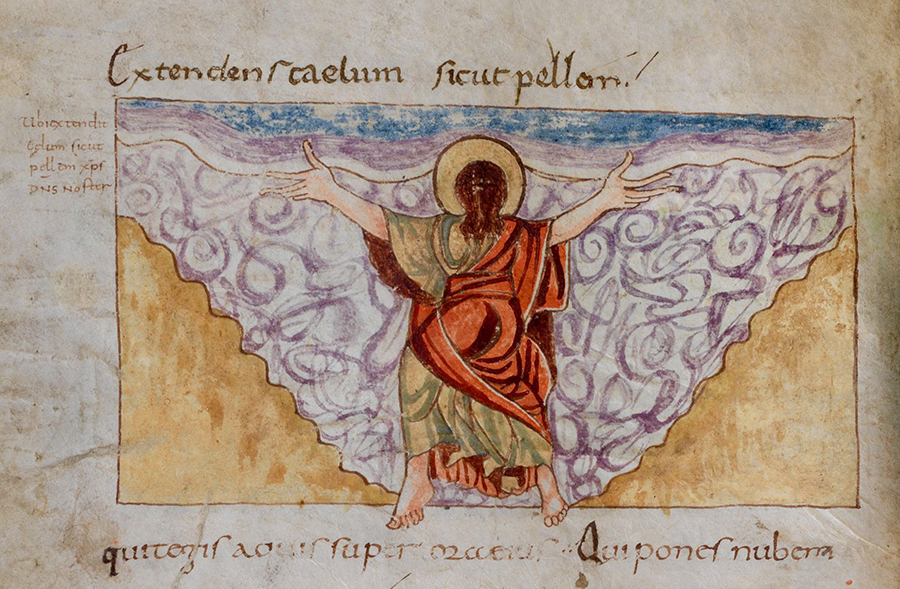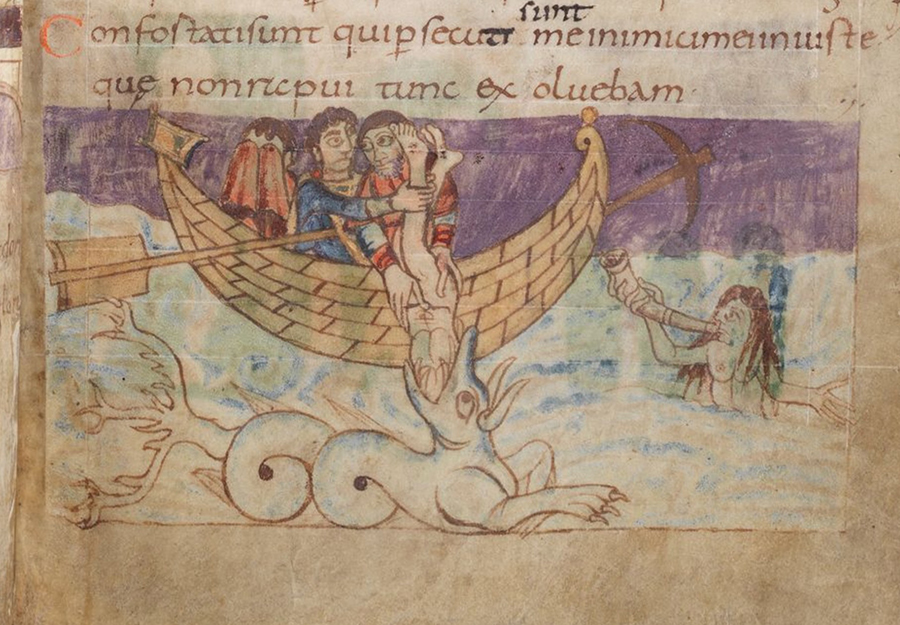Marius B. Hauknes
The Medieval Image of Chaos

The Biblical God and the Unruly Sea, c. 820–830, pen and colored wash on parchment, Württembergische Landesbibliothek Stuttgart, Cod. bibl. fol. 23, fol. 116v. Photo: Württembergische Landesbibliothek Stuttgart
The medieval world forged a philosophically complex and contextually malleable understanding of the term chaos. In cosmological theory, chaos explained how the universe had been formed and why the world inhabited by humans looked the way it did. At the levels of history and theology, chaos provided answers to some of life’s fundamental questions. It explained the existence of death, evil, and enmity in the world—and it could even explain why human life was experienced as an unending struggle against forces beyond one’s control. Chaos could also serve as a rhetorical instrument for political, ethnic, and religious othering. Foreign deities, political rivals, and the unfamiliar customs and beliefs of others were habitually characterized as manifestations of cosmic disorder.
Medieval painters and sculptors developed a rich visual vocabulary for depicting this malleable concept. Chaos could be portrayed, for example, as rays of darkness infiltrating heavenly light; as a raging sea stirring beneath calm surface waters; as formless matter gyrating within diagrams of microcosmic perfection; as monstrous creatures lurking at the edges of the inhabitable world; or as foreign deities dwelling in the waters of baptism. Such images appear in most contextual settings for which medieval artworks were produced and in the majority of artistic media in which medieval artists worked. Yet, there is to date no scholarly examination of this remarkable pictorial tradition in medieval visual culture. My book project, “The Medieval Image of Chaos,” hopes to fill this gap in our understanding of medieval art. The study will unearth a substantial assemblage of chaos motifs found in medieval sculptural decorations, book illuminations, and wall paintings. These works will be examined in relation to period literary and philosophical discourses, political developments, and ritual practices.
During my time at the Center, I have primarily focused on the first chapter of the book, titled “Aquatic Chaos.” This chapter examines how medieval artists visualized chaos through representations of waters, seas, and rivers. One of the primary motifs for chaos in the biblical tradition was that of the primordial sea. In richly evocative imagery, chaos is repeatedly portrayed as a rebellious ocean whose unpredictable movements and life-threatening potency posed a continual threat to the world’s alleged orderliness. This understanding of chaos as a malevolent sea was brilliantly captured in a book illumination from the ninth-century Stuttgart Psalter. The image shows the biblical Creator positioned before a vast, turbulent sea. With his back turned to the viewer and arms splayed in a gesture of divine command, the figure stands as a protective barrier between humanity and the forces of chaos. The image exemplifies how medieval artists envisioned chaos by responding to ancient mythopoeic writings. In the manuscript, the image appears in the context of Psalm 104, a text that reflects on the struggle between the Old Testament God and the unformed wetness that preceded the world’s creation. Taken together, the ancient text and the medieval image figure the impermanence of the world inhabited by humans, which is dependent on a divine figure’s ongoing commitment to keeping the forces of chaos at bay.

Jonah and Leviathan, c. 820–830, pen and colored wash on parchment, Württembergische Landesbibliothek Stuttgart, Cod. bibl. fol. 23, fol. 79r. Photo: Württembergische Landesbibliothek Stuttgart
The ancient mythopoeic understanding of the sea as chaos carried over into medieval representations of New Testament episodes as well. Manifold images of Christ walking on water (Mark 6) and rebuking the stormy sea (Mark 4) can be seen to invoke the age-old understanding of the sea as an ungodly realm of chaos. The chaos-struggle motif also appears in telling representations of Christ’s baptism. Medieval images of the baptism show that this biblical episode was understood not only as a reenactment of the story of the Red Sea crossing (Exodus 14) but also as a form of exorcism wherein the pagan gods for whom water was a natural habitat were driven away in fear. The chapter also highlights the frequent appearance of the twisting sea serpent Leviathan in representations of the Old Testament prophet Jonah. This can be seen, for example, in another image from the Stuttgart Psalter, which depicts the creature that swallowed Jonah as a serpentine dragon that visually blends into its watery habitat. While the sea monster is clearly outlined in bold pen strokes, its body is left essentially transparent, as though to emphasize an elemental equivalence between the sea and its monstrous personification. Their interchangeable nature is further underscored by the figure of Jonah, for whom being tossed into the sea is a clear equivalent to being dropped into the gaping mouth of Leviathan.
University of Notre Dame
Ailsa Mellon Bruce Senior Fellow, 2022–2023
Marius B. Hauknes will return to the Department of Art, Art History, and Design at the University of Notre Dame, where he is assistant professor of medieval art.
